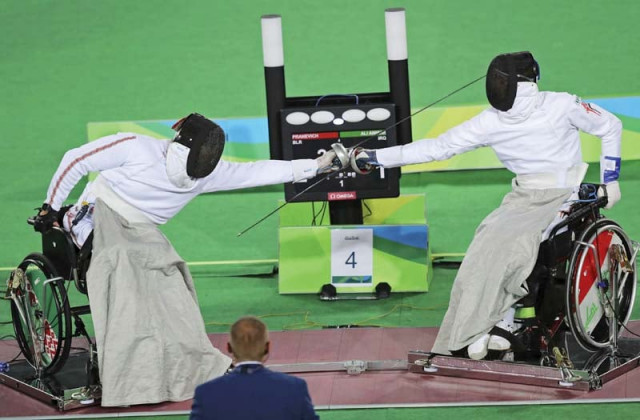Wheelchair warriors revolutionising duels
Fencing providing avenues for paralympians to engage in combat sports

Combatants must remain seated in wheelchairs attached to the floor, largely immobilising their lower bodies, whether the athletes’ legs are paralysed or not. PHOTO: REUTERS
Many skilful athletes are overcoming a lot of disabilities at the Rio Games. However, fencers have a unique edge.
“It’s one of the only combat sports you can do in a wheelchair,” 43-year-old Pierre Mainville, who reached the quarter-finals with the sabre, said on Thursday.
Haider Ali bags bronze for Pakistan in 2016 Paralympics
The Canadian took up wheelchair fencing 15 years ago after a policeman bent on killing an ex-girlfriend fired repeatedly into the car carrying her and three others, including Mainville. He was hit six times and left a paraplegic.
If a modern weapon almost took his life, the ancient sword helped him win it back.
“When you put on that mask, you become a warrior,” he said.
Combatants must remain seated in wheelchairs attached to the floor, largely immobilising their lower bodies, whether the athletes’ legs are paralysed or not.
Small wonders: Dwarfs with giant talents
Free from the waist up, the fencers engage in furious duels, lunging, parrying and leaning back to escape. The clink and scraping of steel blade against blade fills the air, interrupted by occasional cries of victory or disappointment.
“It’s like chess,” said Mainville. “Only very fast.”
The fighters resemble something between aliens, ninjas and medieval knights.
They wear dark masked helmets and white suits wired to register an opponent’s hit. Blankets closing off the area from the waist to the feet are worn like flowing skirts.
The white clothing dates from the days of aristocrats in duels, Mainville says. “They made rules where the first one to bleed loses. Then people tried to cheat by wearing dark clothes, so they said from now on everyone must wear white.”
Like Mainville, Brazilian swordsman Fabio Luiz Damasceno, 33, was paralysed from the waist down in a shooting. He described the incident as occurring ‘in a street fight’.
Damasceno says he discovered wheelchair fencing — a sport that has been in the Paralympics since 1960 but only recently arrived in Brazil — by ‘pure chance’.
And it wasn’t easy to learn the skills needed to wield his weapons of choice, the epee and foil.
“You’re working at very close range, so you have to attack quickly and get out of the way quickly,” he says. “There’s a lot of training. You have to repeat things 10,000 times to do them well.”
Published in The Express Tribune, September 17th, 2016.
Like Sports on Facebook, follow @ETribuneSports on Twitter to stay informed and join in the conversation.



















COMMENTS
Comments are moderated and generally will be posted if they are on-topic and not abusive.
For more information, please see our Comments FAQ